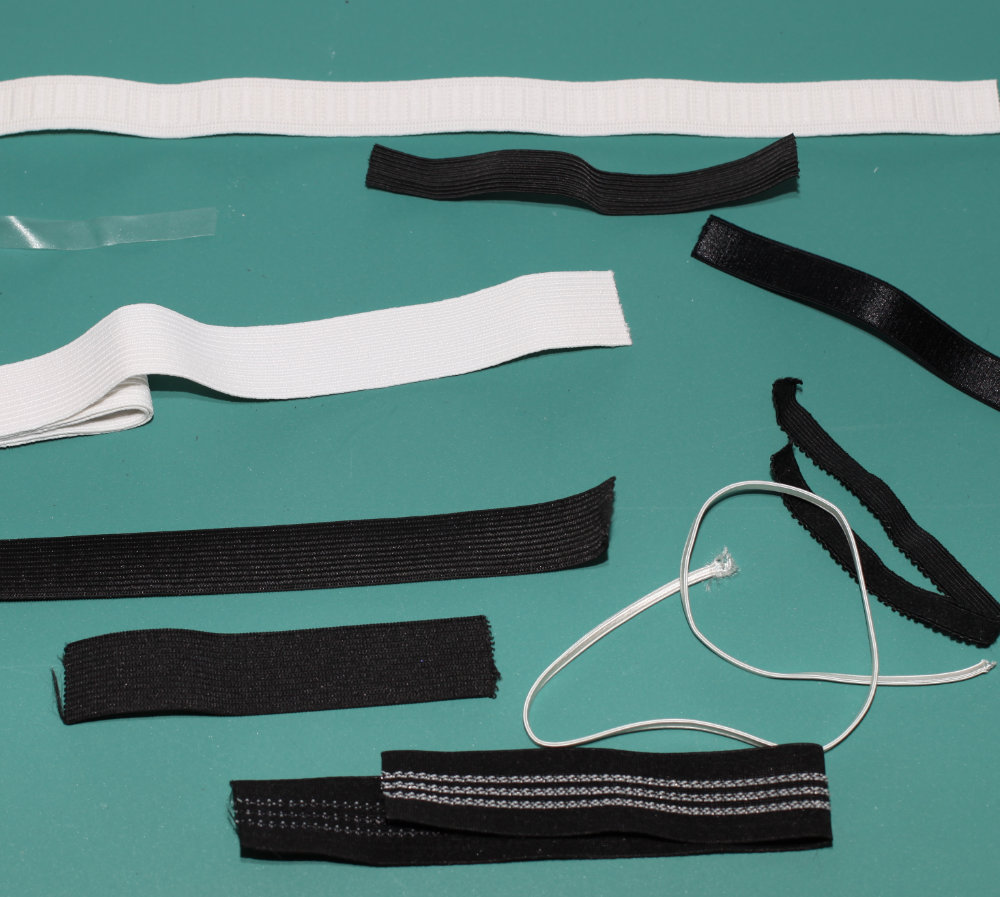Elastic.
Such a useful notion. (Or, is it a fabric?)
But when you try to buy elastic, you’re faced with gasp choices!
The three most common elastics that you’ll find are: Knit, Braided, and No-Roll. However there are other options like clear, strap elastic, picot edge, drawstring, and many more.
With the exception of the clear elastic, which behaves like a sheet of rubber, most of the other elastics will behave like one of the top three.
Here’s a deeper dive.

Stretch
What makes elastic stretch?
Well, in most elastics there’s a rubber or some sort of rubber-like substance that is incorporated into the construction of the elastic. Then the material that makes the elastic covers the rubber bits and you get something that you can sew through.
This isn’t the case with the clear elastic where the rubber bit is the elastic and when you sew through it you leave puncture holes.
“Normal” elastics like the three types mentioned in depth in a few sentences, act more like fabric with a large elastane or rubber fiber wound about the structure.
This means that when you are sewing elastic, you may have issues if using a needle that doesn’t play nicely with the type of elastic or the rubbery elastic bits within.
My favorite needle type to use when sewing elastic is a stretch needle. You can also try a ball point or jersey needle. But sometimes when using a universal, you’ll notice the elastic bits getting pulled out of the elastic itself leading to uneven surface and unsightly bulges.
Knit Elastic
Knit elastic is a good all-around elastic. The fibers that make the elastic are knit together.
This means they could unravel.
But knit elastic is not stiff in its width. So if you need firmness across the width, knit isn’t the type for you.
Knit elastic does not shrink in width with stretched.
This makes knit elastic ideal for applications where knit the elastic stretches but needs to retain its width dimension.
The most obvious application that I can think of, unfortunately, is the multi-tiered ruffle mini-skirts from the ‘80s that use a 3 or 4” wide elastic as the waistband.
Elastic used for bra bands, the tops of underwear, leg openings on underwear, and even leggings waistbands might be better off with knit elastic because it will retain its width.
This kind of elastic is good for applications where it would be unsightly, or uncomfortable if the width gets narrow when stretched.
Braided Elastic
Braided elastic actually does get narrower when stretched. It feels firmer than knit elastic. Use this where the retention of the elastic width doesn’t matter. I’ll frequently use braided elastics in casings. The casing retains the width so it’s Ok if the elastic gets a little narrow.
Honestly, the biggest difference I see between the braided and the knit elastic in performance is the shrinkage.
But, they are constructed differently.
You’ll probably notice a difference in firmness and texture. The knit elastics feel more like fabric (marginally) and the braided elastics will feel a bit firmer.
When I sew them, I sew them the same. And, I usually use them interchangeably, but they are different.
One will feel more stretchy than the other. Even if they have the same percentage of stretch, the knit often feels easier to stretch.
No-Roll Elastic
No-roll elastic has vertical (width-wise) ridges that are supposed to keep it from folding over on itself.
Both braided and knit elastics will easily fold over.
With this width-wise stability comes stretch resistance. …. No-roll elastic doesn’t have the same stretch percent as knit or braided.
You might prefer this type of elastic in waistband casings where you don’t want the elastic to fold over and get deformed from stretch.
But also, if you make a garment that is heavier with an elastic waistband, then a no-roll elastic will give you more support of your fabric. One of the examples I have from experience is a large tiered bellydance skirt. When made from a lighter weight fabric, like a light-weigh crinkle satin, the weight pulling on the elastic isn’t that great. But, if you use a super heavy-weight satin, the weight of the fabric will pull the waistband down. Braided or knit elastic will struggle to give enough support, but no-roll elastic could work. However, I’d recommend using a lighter weight fabric for that type of garment. BUT, if you have your heart set on heavy fabric, try the no-roll.
One thing about no-roll elastic is that it is distinct in appearance. You could get away with showing your braided or knit elastic. BUT, you probably won’t want to show off the no-roll elastic with it’s vertical ridges.
So, it’s best used in a casing or a covered fold-over application.
Wrap-Up
There are many different types of elastics available. But, of the three main types: No-roll, knit and braided, the biggest differences are the stretch percentage (how firm they are) and whether they deform when stretched.
I generally choose the type of elastic based on what I have on hand, but, if I needed elastic that doesn’t deform, or elastic that offers more support I may choose one type over another.
It’s important to know that they aren’t all the same. And, they do behave differently and serve different purposes.
Explore Sewing Projects at Your Own Pace
Learn helpful techniques and tips to make sewing more enjoyable.
